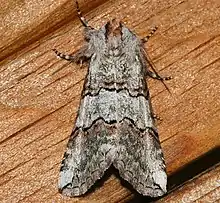| Ceranemota fasciata | |
|---|---|
 | |
| Scientific classification | |
| Domain: | Eukaryota |
| Kingdom: | Animalia |
| Phylum: | Arthropoda |
| Class: | Insecta |
| Order: | Lepidoptera |
| Family: | Drepanidae |
| Genus: | Ceranemota |
| Species: | C. fasciata |
| Binomial name | |
| Ceranemota fasciata (Barnes & McDunnough, 1910) | |
| Synonyms | |
| |
Ceranemota fasciata is a moth in the family Drepanidae. It was described by William Barnes and James Halliday McDunnough in 1910.[1] It is found in North America, where it has been recorded from British Columbia to northern California. It is also present in coastal southern Alaska.[2] The habitat consists of coastal rainforests, mixed hardwood forests and montane riparian areas.
The larvae feed on Amelanchier alnifolia and Prunus species, including Prunus ilicifolia and Prunus virginiana.[3]
References
- ↑ Beccaloni, G.; Scoble, M.; Kitching, I.; Simonsen, T.; Robinson, G.; Pitkin, B.; Hine, A.; Lyal, C., eds. (2003). "Ceranemota fasciata". The Global Lepidoptera Names Index. Natural History Museum. Retrieved May 17, 2018.
- ↑ "850011.00 – 6243 – Ceranemota fasciata – (Barnes & McDunnough, 1910)". North American Moth Photographers Group. Mississippi State University. Retrieved June 7, 2019.
- ↑ Pacific Northwest Moths
This article is issued from Wikipedia. The text is licensed under Creative Commons - Attribution - Sharealike. Additional terms may apply for the media files.